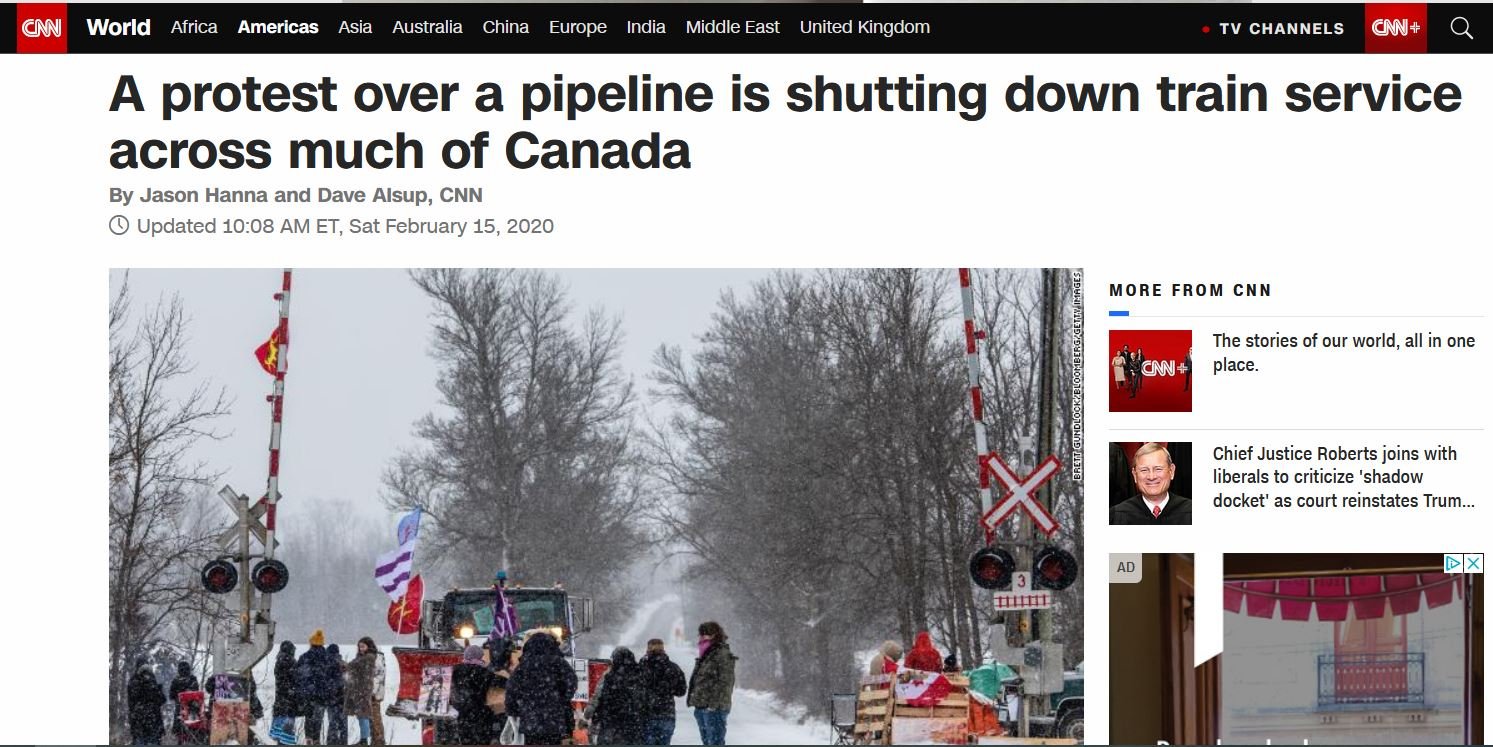Case 4: Wet’suwet’en Land Defenders
The crowd holds a protest banner at a Wet'suwet'en Solidarity Event at the Rail Yard in Vaughan, Toronto, on Feb. 15, 2020. (Jason Hargrove/Flickr via Global Citizen)
My fourth and final example is the ongoing mobilization of Indigenous land defenders from the Wet’suwet’en nation and their supporters against the proposed Coastal GasLink pipeline that would transport natural gas across British Columbia for export to Asia.
The pipeline would cross unceded Wet’suwet’en territory, and a group of hereditary Wet’suwet’en chiefs have led the opposition to its construction, joined by other Indigenous and environmental activists from across Canada and beyond. In early 2019, Indigenous land defenders began setting up blockades designed to prevent access to the construction camps. Since that time, the project has been the subject of a protracted legal battle as well as aggressive actions by the Royal Canadian Mounted Police against the land defenders.
The situation generated significant news coverage in February 2020 when Canada saw nationwide protests in support of the Wet’suwet’en chiefs. These protests included a series of very effective blockades of major railway lines as well as other actions. Resistance has continued since that time, as has the construction, and parent company TC Energy reported earlier this year that the project is now roughly 60 percent complete.
Privileging settler concerns
Coverage of the 2020 blockades provided an excellent opportunity for establishment media to make the explanatory link between settler colonialism and the very foundations and contemporary structures of Canada’s settler economy.
Journalists immediately framed the story as newsworthy because the actions of the land defenders and their allies represented a significant disruption of the country’s transportation and commercial arteries. NPR’s reporting, for example, focuses on how the actions will affect the Canadian economy and pose an inconvenience for travelers. One report does quote Molly Wickham, a spokesperson for the hereditary chiefs, but her pointed comment about Indigenous jurisdiction and sovereignty over unceded land (“The federal government and the province both have a responsibility to acknowledge that the Wet'suwet'en have never ceded, surrendered or extinguished our title to our lands. And we have full jurisdiction and authorization to make decisions on our territory.”) ended up as another missed opportunity to explore challenges to the legitimacy of the settler state itself.
CNN’s only report on the story leans even more heavily into the “disruption” frame, failing to provide even a single quote from anyone representing the land defenders.
Screen capture of CNN report on protests in solidarity with Wet’suwet’en land defenders.
Framing: “reconciliation” and “law and order”
For its part, the New York Times began its coverage with a lengthy article that also adopts the “disruption” frame, albeit with more detail than NPR or CNN provided. Then, curiously, in the penultimate paragraph, Times reporter Ian Austen mentions a crucial fact: “The Wet’suwet’en have never signed a treaty and in 1997 Supreme Court of Canada ruled that they hold ‘Aboriginal title’ to the territory now involved in the dispute.” Subsequent coverage makes multiple references to this decision but never bothers to explore why the issue hasn’t been taken up since or what its significance might be.
Instead, the coverage emphasizes the dilemma faced by Prime Minister Justin Trudeau as he sought to balance his emphasis on “reconciliation” with Indigenous nations with the pressure coming from conservative politicians to restore “law and order” and prevent further economic disruption. The coverage presents the government’s commitment to “reconciliation” as an uncomplicated fact, ignoring the perspective of some Indigenous groups and scholars who argue that “reconciliation” is a liberal smokescreen designed to perpetuate colonial relations.
On February 21, 2020, the Times published a lengthy “explainer” piece by Austen, their reporter based in Canada. The article provides background on a range of issues surrounding the pipeline project and the resistance to it. Much of this contextual information, however, raises more questions than it answers.
Screen capture of New York Times article providing background on the Wet’suwet’en story
For example, Austen notes that there are sharp differences between the Wet’suwet’en hereditary leadership and the elected “band councils” of Indigenous nations affected by the pipeline, with the latter generally supporting the project. The “band councils,” he writes, “were put in place by the federal government in the 19th century.” But how should we understand that particular piece of history in relation to things like present-day energy politics or indeed the entire structure of the Canadian economy and transportation system?
The absence of settler colonialism from the reporting leaves readers to connect the dots for themselves without the benefit of hearing from scholars who have connected those dots in a systematic way.



